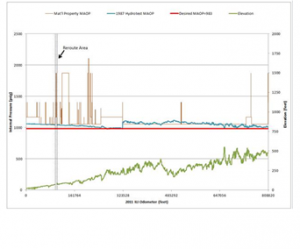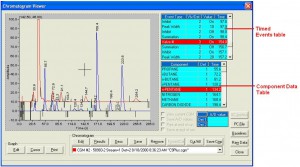December 2009 Vol. 236 No. 12
Features
Large-Diameter Plastic Pipe Mains Are Helping Gas Distribution

Ever since Union Gas in Caney, KS successfully inserted a 4-inch polyethylene pipeline into a corroded 6-inch steel pipeline in 1959, polyethylene pipes have steadily become the material of choice for the North American gas distribution market.
Polyethylene alone represents more than 39 million services and 3 billion feet of the pipes in service (1), and more than 97% of all new gas distribution piping installed each year.
Throughout the 50 years of service, polyethylene pipe resins and pipes have improved in both toughness and durability from the original pipelines that have served our industry well.

Figure 1.
Despite the success of polyethylene pipe in the gas distribution industry, only 10% (by length) of new polyethylene gas distribution mains are larger in diameter than six inches IPS (Figure 1). This occurs even though polyethylene pipe is generally found to be less expensive to install than protected steel mains as reported in Pipeline & Gas Journal’s 43rd Annual Pipe Report based on a survey of utilities (Table 1).
Several large utility companies today are using or evaluating polyethylene pipes up through 12-inch diameter due to both the performance of polyethylene pipe and the cost savings through operations and installation. Twelve-inch diameter polyethylene pipes are now considered standard products for both trenchless and open-cut installations. Pipelines larger than 12-inch have also been installed and are operating successfully. One of the earliest installations larger than 12-inch diameter occurred in 1989 with a 20-inch diameter pipe sliplined into existing cast iron mains in Colorado.(2)
![]()
Table 1. Source: Tubb, Rita, “43rd Annual Pipe Report — Gas Demand, Maintenance Projected to Drive Distribution Spending,” Pipeline & Gas Journal, Dec. 2008.
With lower installation costs and a proven long-term service life, the question remains as to why the use of larger diameter polyethylene pipe mains has lagged the use of larger diameter pipelines in other industries such as water, wastewater, mining, firewater and many other industrial applications where polyethylene pipes are routinely installed up through 65-inch diameter.
While the confidence in polyethylene pipe is high, there can be a perception of logistical and operational obstacles to integrating large-diameter polyethylene mains into gas distribution. Two case studies are offered as evidence of the suitability and ease of installation of large-diameter polyethylene pipes for gas distribution.
Chicago, IL (see image, “18-inch pipe installation in Chicago, IL”). With a customer base of 830,000, Peoples Gas, a subsidiary of Integrys Energy Group, serves the city of Chicago. The utility uses polyethylene pipe extensively because of the pipe’s corrosion resistance, cost effectiveness and ease of installation. For Peoples Gas, the driving force to move to larger diameters was the need for a cost-effective rehabilitation of older cast-iron pipelines.
Peoples Gas distribution lines have an MAOP of 25 psi. However, many sections of the city are still serviced by low-pressure mains (inches of H2O). By increasing the pressure, the existing cast-iron lines can be insert-renewed with polyethylene lines while maintaining the same flow rate and providing a leak-free replacement pipe with minimal impact on the public.
Peoples Gas routinely installs 18-inch diameter gas pipe using the sliplining process to renew aging cast iron lines. By using a trenchless application, they avoid excavation to replace the pipe, which is significantly more expensive. They also avoid open-cut installation which creates a noticeably negative impact on local citizens through damage to existing paving and landscaping as well as the resulting traffic congestion from construction. Peoples Gas has used 18-inch diameter pipe to slipline 20-inch, 24-inch, and 30-inch cast-iron lines.
John Goetz, General Manager-Construction, Operations and Maintenance for Peoples Gas, reports that “using 18-inch diameter PE pipe is a very cost effective solution, especially where you can slipline an existing cast-iron pipe or use other trenchless techniques. It isn’t that much different than working with 8-inch or 12-inch once you find your source for the appurtenances. The cost savings are incredible when you compare it to a size-for-size steel installation.”
Instead of the more traditional “pulling” technique, Peoples Gas “walks,” or pushes, the pipe into the existing line for its slipline applications. Their experience is that they have more control over the pipe and the project in the heavily congested areas using the pushing technique. To connect to valves, Peoples Gas uses 16-inch diameter transition fittings. In addition to butt and sidewall heat fusion, 18-inch diameter electrofusion couplings, and 18-inch diameter fabricated fittings are used to complete the system.
A recent application in Chicago involved relining 5,100 feet of a 24-inch cast-iron line that is buried five feet in an area of heavy traffic. The longest section pushed in was 1,800 feet and the work pits were typically 40-60 feet long.

Figure 2.
Kansas City, MO (Figure 2). As a division of Southern Union Company (SUG) (3), Missouri Gas Energy distributes natural gas to a half million customers in 155 western Missouri communities. After more than 60 years of service, it was time to retire the 19,000 feet of 24-inch cast-iron pipe that carried natural gas through Kansas City.
Having successfully used 16-inch polyethylene pipe in a project 20 years earlier, Missouri Gas Energy wanted to replace the cast-iron pipe with polyethylene pipe. Since the line to be replaced ran underneath a major road to supply gas to an established residential neighborhood, trenchless technology was desired to minimize impact on the community. Based on the desired flow rate and the line pressure of 58 psi, the utility specified 20-inch SDR 15.5 PE4710 pipes. For federally regulated natural gas applications, SDR 15.5 polyethylene pipe is rated for up to 71 psi. With the selection of 20-inch pipe, sliplining became the most cost-effective solution.
The pipes were supplied in 50-foot lengths. The installation involved pre-fusing two 50-foot sections together, then pulling the pipe through the hole before joining it to another 100-foot section. The longest piece of pipeline pulled was 1,500 feet. Where fabricated fittings were required, Missouri Gas opted to use fittings produced from 20-inch DR 11 gas pipe to maintain the fitting pressure rating equal to the pipe pressure rating.
According to David Glass, director of engineering and technology for Missouri Gas Energy, the decision to use 20-inch polyethylene pipe was easy. “Despite the fact that 20-inch diameter pipe had never been used in gas distribution, the Kansas City project was very straight-forward. To us, it was a natural choice based on the project’s requirements, and quite frankly, just a bigger and longer version of what we did 20 years ago,” he said.
After decades of successfully using polyethylene pipe in sizes up to 12-inch diameter, utilities are recognizing the potential for larger diameter applications in gas distribution lines. Cities such as Chicago and Kansas City have used large-diameter polyethylene gas pipe mains for many years to renew the cast-iron pipes that reached the end of their service lives. The availability and ease of installation of polyethylene pipes offer safe, economical solutions for large-diameter gas pipe mains.
Acknowledgment
This article is based on a presentation at the American Gas Association Conference and Biennial Exhibition, May 19-21, 2009, in Pittsburgh, PA.
Author
Karen Lively is the technical manager for Performance Pipe, the pipe division of Chevron Phillips Chemical Co. She earned her degree in chemical engineering from the University of Texas at Austin and has worked in polyethylene and polyethylene pipe for more than 30 years. She has held positions in engineering, quality, supply chain and technical management. She can be reached at LIVELKS@cpchem.com.
References
1 American Gas Association (AGA) “2006 inventory of gas distribution pipelines,” www.aga.org.
2 Pipeline & Gas Journal, December 1990.
3 https://www.missourigasenergy.com/MGE/companyInfo/company.jsp.





Comments